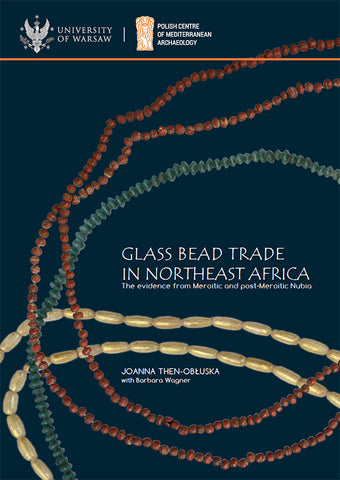Glass Bead Trade in Northeast Africa, The Evidence from Meroitic and post-Meroitic Nubia
85,00 $
ISBN: 978-83-235-3899-8
Description: 315 pages (29,5x20,5cm), softcover, phots., drawings
Condition: new
Weight: 1005g.
Joanna Then-Obluska with Barbara Wagner, Glass Bead Trade in Northeast Africa, The Evidence from Meroitic and Post-Meroitic Nubia, PAM Monograph Series 10, Warsaw 2019
Strings of colorful glass beads were a popular commodity traded throughout ancient Nubia in the earlier half of the first millennium AD. Combining macroscopic examination with laboratory analyses, the author breaks new ground in Nubian studies, establishing diagnostic markers for a study of trading markets and broader economic trends in Meroitic and post-Meroitic Nubia.
Archaeometric results, lucidly presented and discussed, identify the origins of the glass from which the beads under investigation were made. The demonstrated South Indian/Sri Lankan provenance of some of the ready-made beads from Nubian burial contexts and a reconstruction of their distribution patterns in Northeast Africa is the first undisputed proof of contacts between Nubia and the Red Sea coast. Reaching beyond that, it shows Nubia’s involvement in the Asian maritime trade, whether directly or indirectly, during a period of intensive interchanges between the 4th and 6th centuries AD.
Acknowledgements
Introduction
Chapter 1: Nubia in the Meroitic and post-Meroitic periods
Chapter 2: Beads in Meroitic and post-Meroitic cultures: iconographic and contextual overview
Chapter 3: Collections and archaeological contexts
Chapter 4: Morphological description of glass samples
4.1 Introduction
4.2 Techniques, provenance, parallels, and dating
4.3 Conclusions
Chapter 5: Chemistry of glass beads
5.1 Introduction
5.2 Method of analysis ( by Barbara Wagner)
5.3 Results
5.4 Discussion of provenance of glass groups and subgroups
5.5 Conclusions
Chapter 6: Discussion of the glass groups and beads produced
Chapter 7: Trade contacts in Northeast Africa
7.1 Introduction
7.2 Trade hubs, routes and operators in Northeast Africa
7.3 The Nubian trade
7.4 The bead trade
Chapter 8: Conclusions
Catalog
The SJE collection
The SNM collection
The MAP collection
The MNW collection
Parallels
Abbreviations and references
List of figures, tables and plates
Description: 315 pages (29,5x20,5cm), softcover, phots., drawings
Condition: new
Weight: 1005g.
Joanna Then-Obluska with Barbara Wagner, Glass Bead Trade in Northeast Africa, The Evidence from Meroitic and Post-Meroitic Nubia, PAM Monograph Series 10, Warsaw 2019
Strings of colorful glass beads were a popular commodity traded throughout ancient Nubia in the earlier half of the first millennium AD. Combining macroscopic examination with laboratory analyses, the author breaks new ground in Nubian studies, establishing diagnostic markers for a study of trading markets and broader economic trends in Meroitic and post-Meroitic Nubia.
Archaeometric results, lucidly presented and discussed, identify the origins of the glass from which the beads under investigation were made. The demonstrated South Indian/Sri Lankan provenance of some of the ready-made beads from Nubian burial contexts and a reconstruction of their distribution patterns in Northeast Africa is the first undisputed proof of contacts between Nubia and the Red Sea coast. Reaching beyond that, it shows Nubia’s involvement in the Asian maritime trade, whether directly or indirectly, during a period of intensive interchanges between the 4th and 6th centuries AD.
Acknowledgements
Introduction
Chapter 1: Nubia in the Meroitic and post-Meroitic periods
Chapter 2: Beads in Meroitic and post-Meroitic cultures: iconographic and contextual overview
Chapter 3: Collections and archaeological contexts
Chapter 4: Morphological description of glass samples
4.1 Introduction
4.2 Techniques, provenance, parallels, and dating
4.3 Conclusions
Chapter 5: Chemistry of glass beads
5.1 Introduction
5.2 Method of analysis ( by Barbara Wagner)
5.3 Results
5.4 Discussion of provenance of glass groups and subgroups
5.5 Conclusions
Chapter 6: Discussion of the glass groups and beads produced
Chapter 7: Trade contacts in Northeast Africa
7.1 Introduction
7.2 Trade hubs, routes and operators in Northeast Africa
7.3 The Nubian trade
7.4 The bead trade
Chapter 8: Conclusions
Catalog
The SJE collection
The SNM collection
The MAP collection
The MNW collection
Parallels
Abbreviations and references
List of figures, tables and plates

